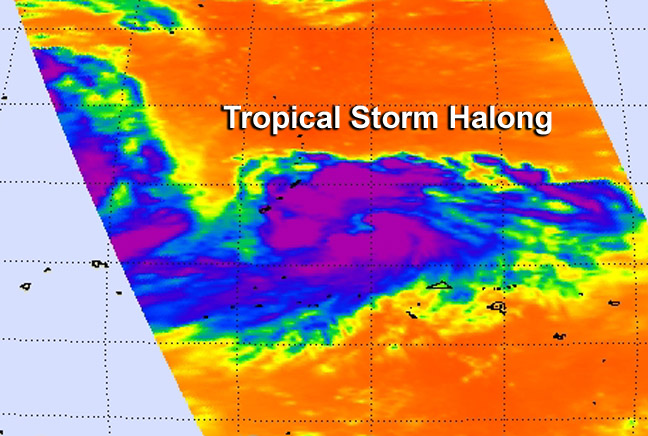NASA Sees Developing Tropical Storm Halong Causing Warnings

NASA's Aqua satellite passed over Tropical Storm Halong on July 29 at 03:29 UTC infrared data showed very cold thunderstorm cloud top temperatures of surrounding the center and developing eye. Image Credit: NASA JPL
When NASA's Aqua satellite passed over Tropical Storm Halong on July 29 at 03:29 UTC (July 28 at 11:29 p.m. EDT) the Atmospheric Infrared Sounder instrument captured data on the cloud cover.
The infrared data showed very cold, high thunderstorm cloud top temperatures of powerful storms surrounding the center, with what appears to be an eye developing.
Microwave satellite data also shows a small eye, with tightly-curved bands of thunderstorms wrapping into it.
A warning is in force for Rota and a Tropical Storm Watch is in effect for Guam, while a typhoon watch is also in effect got Guam.
On July 29 at 1500 UTC (11 a.m. EDT), Tropical Storm Halong's maximum sustained winds were near 55 knots (63.2 mph/101.9 kph). Halong was centered near 13.7 north latitude, approximately 134 nautical miles (154 miles/248 km) east of Andersen Air Force Base.
Halong has tracked northwestward at 11 knots (12.6 mph/20.3 kph).
The Joint Typhoon Warning Center forecast indicates that Halong will move to the west-northwest through the Marianas Islands while continuing to intensify.
Text credit: Rob Gutro
NASA's Goddard Space Flight Center
Media Contact
All latest news from the category: Earth Sciences
Earth Sciences (also referred to as Geosciences), which deals with basic issues surrounding our planet, plays a vital role in the area of energy and raw materials supply.
Earth Sciences comprises subjects such as geology, geography, geological informatics, paleontology, mineralogy, petrography, crystallography, geophysics, geodesy, glaciology, cartography, photogrammetry, meteorology and seismology, early-warning systems, earthquake research and polar research.
Newest articles

Properties of new materials for microchips
… can now be measured well. Reseachers of Delft University of Technology demonstrated measuring performance properties of ultrathin silicon membranes. Making ever smaller and more powerful chips requires new ultrathin…

Floating solar’s potential
… to support sustainable development by addressing climate, water, and energy goals holistically. A new study published this week in Nature Energy raises the potential for floating solar photovoltaics (FPV)…

Skyrmions move at record speeds
… a step towards the computing of the future. An international research team led by scientists from the CNRS1 has discovered that the magnetic nanobubbles2 known as skyrmions can be…




















